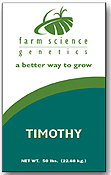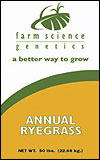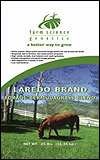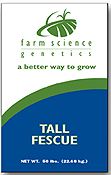 |
 |
 |
|
|
| |

Derby Timothy
Dessie Teff
DH-3 Annual Ryegrass
Eco-Till™ Soilbuster™ Radish
Fria Annual Ryegrass
FSG 506 Orchardgrass
Laredo Bermudagrass
Select Tall Fescue
Small Package Forage Available
|
|
 |
|
 |
|
|
 |
|
|
 |
 |
|
|
| |
 |
Derby Timothy
- Early maturing variety
- Excellent winter hardiness and yield potential
- Selected for improved regrowth after cutting
- Excellent companion to legumes in mixtures
|
| Management Recommendations |
| Planting Rate (pure) |
6 - 10#/A |
| Planting Rate (mix) |
2 - 4#/A |
| Seeding Dates (Spring) |
3/1 - 5/15 |
| Seeding Dates (Summer) |
8/1 - 9/15 |
| Minimum Soil pH |
5.5 |
|
|
|
 |
|
 |
|
|
 |
 |
 |
|
|
| |
 |
DH-3 Annual Ryegrass
- Highly productive for hay, green chop or pasture
- Excellent palantability
- Spreads rapidly
- Extremely heat tolerant
- Cold tolerant
- Drought tolerant
|
| Management Recommendations |
| Planting Rate (pure) |
12-15#/A |
| Planting Date |
Spring - Summer |
| Minimum Soil pH |
5.5 |
|
|
|
 |
|
 |
|
|
 |
 |
 |
|
|
| |
Eco-Till™ Soilbuster™ Radish
- Superior, deep penetrating taproot
- Reduces soil compaction
- Builds organic matter
- Improves nutrient recycling
- Excellent weed suppression
- Enhances soil tilth
Eco-Till™ Soilbuster™ Radish is a new Daikon type forage radish specifically developed for
fall/winter cover crop applications. These radishes offer impressive benefits to the soil and the
environment including the reduction of soil compaction, improved nutrient recycling, increased
organic matter, enhancement of soil tilth and suppression of weeds to name a few.
A superior, deep penetrating taproot is one characteristic that separates Eco-Till™ Soilbuster™
radishes from the competition. The thin, lower portion of the taproot can grow to a depth of six feet or
more while the thick upper portion of the taproot can grow to a length of 24 inches. This taproot
creates vertical holes in the soil profile that breaks up soil compaction and improves soil tilth. This
process, known as "bio-drilling", improves water infiltration, aeration and fertilizer efficiency for
succeeding crops. Equally important is the ability of these radishes to take up nutrients from the soil
profile to be stored in the tissues near the soil surface and make them readily available for use by the
following crop.
|
| Management Recommendations |
| Planting Rate |
Conventional or No-Till Drill: 8-10 lbs/Acre.
Broadcast: 12-15 lbs/Acre (broadcast seed needs a
light disking or rolling with a corrugated roller to
ensure proper seed to soil contact). |
| Planting Date |
North of Interstate 80 - Late July to
August 15. Between Interstate 40 & Interstate 80 -
Late July to September 15. |
| Seeding Depth |
1/4 - 1/2 inch (can be planted
up to 1" if soil conditions are dry) |
| Germination |
3-7 days (with proper soil
temperatures and moisture) |
| Fertility |
Apply as directed by soil test.
Nitrogen deficiency will limit overall growth,
the ability to compete with weeds and root
penetration through compacted soils. |
| Soil pH |
6.5 - 7.0 (for optimum performance) |
|
|
|
 |
|
 |
|
|
 |
 |
 |
|
|
| |
Fria Annual Ryegrass
- Superior cold tolerance
- High forage yield
- Excellent for overseeding
- Ideal cover crop
- Great disease resistance
- Excellent palatability
Fria annual ryegrass not only delivers outstanding yields in the south and north, but has
exceptional cold tolerance that helps in fall establishment and winter survival
throughout the transition zone and further north. Developed by Dr. Gordon Prine at the
University of Florida for cold tolerance, improved crown rust resistance and resistance
to gray and helminthosporium leaf spot; Fria is a late maturing diploid variety.
For forage production, Fria is typically seeded into dormant warm season grass
pastures or after wheat and corn silage harvest to provide grazing, hay, haylage or
greenchop through the winter and spring. Planting dates are from August to November
depending on the region. Recommended seeding rates are 20-25 pounds per acre drilled
early (August-early September), 25-30 pounds per acre drilled later (late September-
November) or 25-35 pounds per acre broadcast. Fria provides consistent high quality
forage production and excellent grazing under proper management. For hay or haylage,
cut when the plant is between the boot and early head stage for optimum yield and
quality. For grazing and green chop, start when Fria is 8 to 10 inches tall. Do not graze
or greenchop lower than 3 inches.
As a cover crop, Fria can break up natural and manmade hardpans with its deep root
penetration when planted in a continuous no-till rotation. Up to 30-90 pounds of
nitrogen per acre can be provided for the following crop by recycling the nitrogen in the
soil under no-till farming management as long as it is not harvested or grazed. The
ability to capture and keep nitrogen and phosphorus in the soil profile after manure
applications, preventing nutrient runoff is another big plus. Fria can also greatly reduce
soil erosion, especially when planted after corn. Other benefits include reducing soybean
cyst nematode populations and potential increased corn and soybean yields due to
improved soil characteristics.
|
Annual Ryegrass Survival Trial
Lexington, KY
2005 - 2006 Data
|
| Variety |
Survival Rating |
Total |
| Marshall |
4.2 abc |
5231 ab |
| Fria |
4.7 a |
5201 ab |
| Thunder |
4.2 abc |
5099 abc |
| FL x2002 (LA3) LRCT |
4.2 abc |
5048 abc |
| Ed |
3.2 cd |
4929 abc |
| Attain |
3.0 d |
4767 abc |
| Stockaid |
3.5 bcd |
4588 abc |
| Jumbo |
2.7 d |
4154 c |
| T-Rex |
3.0 d |
4149 c |
| Gulf |
2.7 d |
4069 d |
| Big Daddy |
2.5 d |
4018 d |
Annual Ryegrass Survival Trial
University of Nebraska| Scottsbluff, NE
2005 - 2006 Data
|
| Variety |
Surviving Stand % |
| Fria |
99 |
| Marshall |
99 |
| Surrey II |
98 |
| Ed |
95 |
| Winterhawk |
95 |
| Gulf |
51 |
| Jumbo |
41 |
|
|
|
 |
|
 |
|
|
 |
 |
 |
|
|
| |
FSG 506 Orchardgrass
- Early-Medium Maturity
- Excellent foliar disease resistance
- Great forage yield potential
- Improved stand persistence
- Selected for seedling vigor
- Quick recovery
- Excellent Color
FSG 506OG is an early-medium maturing orchard grass that is an excellent choice for hay, silage and pasture.
This variety was selected for its improved seedling vigor, high yield potential and excellent disease resistance.
FSG 506OG is ideal for planting as a straight product or in mixes with other grasses and legumes.
Management Suggestions
Fertilizer (pure stand) - Nitrogen should be applied in split applications during early Spring & Fall and after the 1st cutting.
Adequate phosphorus and potassium are also necessary for top forage production.
Cutting Schedule
First cutting in spring should be done before head emergence (Boot Stage). Later cuttings can be made at 4-6 week intervals depending on conditions.
Leave a 4-5 inch stubble for quick recovery and longer stand life.
Grazing
Rotational grazing is preferred for best production, persistence and quality.
Fields should be grazed heavily and frequently (every 10-12 days) during the rapid spring growth period but overgrazing should be avoided.
Leave a 4-5 inch stubble for quick recovery and longer stand life.
|
FFR Performance Data - Kentucky and Virginia
|
| Entry |
%Mean |
Foliar Disease* |
| FSG 506OG |
106 |
3.4 |
| Benchmark Plus |
101 |
6.1 |
| Persist |
98 |
5.5 |
| Prairie |
101 |
6.8 |
*Rating: 1=little or no disease, 9=90%+ infection; mean of 6 field ratings...
|
|
|
 |
|
 |
|
|
 |
 |
 |
|
|
| |
 |
Laredo Bermudagrass
- Highly productive for hay, green chop or pasture
- Excellent palantability
- Spreads rapidly
- Extremely heat tolerant
- Cold tolerant
- Drought tolerant
|
| Management Recommendations |
| Planting Rate (pure) |
12-15#/A |
| Planting Date |
Spring - Summer |
| Minimum Soil pH |
5.5 |
|
|
|
 |
|
 |
|
|
 |
 |
 |
|
|
| |
 |
Select Tall Fescue
- Low endophyte fescue
- Wide area of adaptation
- High forage yields
- Excellent for winter stockpiling
- Excellent hay and pasture variety
|
| Management Recommendations |
| Planting Rate (pure) |
15 - 20#/A |
| Planting Rate (mix) |
8 - 10#/A |
| Seeding Dates (Spring) |
3/1 - 5/15 |
| Seeding Dates (Summer) |
8/1 - 9/15 |
| Minimum Soil pH |
5.5 |
| Stockpiling Capabilities |
Excellent |
|
|
|
 |
|
 |
|
|
 |
|
  |
|